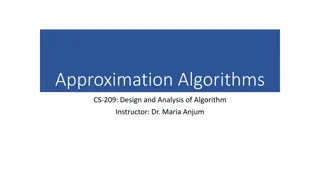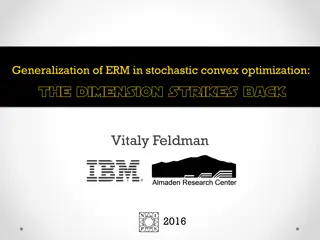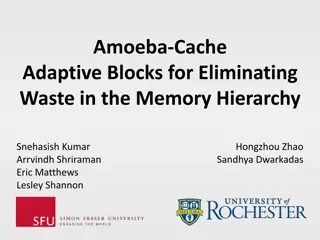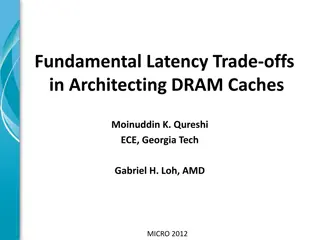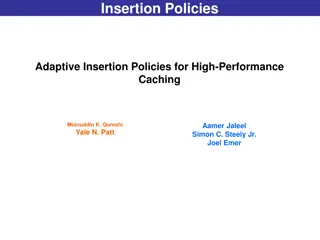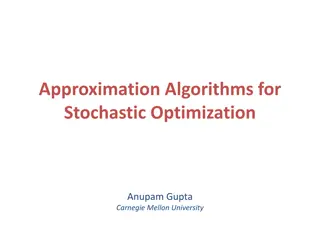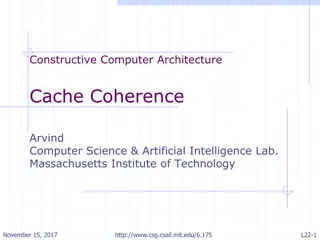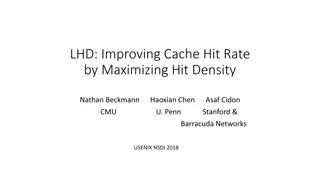Online Algorithms and Cache Optimization
This comprehensive overview delves into the efficient management of pages and caches in computer systems. Explore the k-Server Problem, Linear Programming, and the intricacies of cache eviction strategies. Discover the competitive algorithms and the role of randomization in enhancing performance.
Download Presentation

Please find below an Image/Link to download the presentation.
The content on the website is provided AS IS for your information and personal use only. It may not be sold, licensed, or shared on other websites without obtaining consent from the author.If you encounter any issues during the download, it is possible that the publisher has removed the file from their server.
You are allowed to download the files provided on this website for personal or commercial use, subject to the condition that they are used lawfully. All files are the property of their respective owners.
The content on the website is provided AS IS for your information and personal use only. It may not be sold, licensed, or shared on other websites without obtaining consent from the author.
E N D
Presentation Transcript
Online Algorithms, Linear Programming, and the k-Server Problem Seffi Naor Computer Science Dept. Technion Approximation Algorithms: The Last Decade and The Next Princeton, June 2011 Joint work with: Nikhil Bansal, Niv Buchbinder, and Aleksander Madry
The Paging/Caching Problem (1) CPU cache Browser cache web
The Paging/Caching Problem (2) Universe of n pages, cache of size k<n. Request sequence of pages 1, 6, 4, 1, 4, 7, 6, 1, If requested page is already in cache, no penalty. Otherwise, cache miss! Cache miss: fetch page into the cache, (possibly) evicting some other page Main Question: which page to evict? Goal: minimize number of cache misses
The Paging/Caching Problem (3) What can be obtained deterministically? Best Algorithm: Evict the least recently used page (LRU) Theorem: LRU is k-competitive. (number of cache misses at most k times the optimal) Theorem: Any algorithm is at least k-competitive.
The Paging/Caching Problem (4) Can randomization help? A lot! Theorem: There is an O(log k)-competitive randomized paging algorithm (marking algorithm, 1988) Theorem: Any randomized algorithm is (log k)-competitive
The k-server Problem k servers (fire trucks) lie in an n-point metric space. Requests arrive at points of the metric space. To serve request: move a server to request point. Goal: Minimize total distance traveled by servers. Example:
The k-Server Conjecture Paging = k-server on a uniform metric. page point; server at location p = page p in cache Lower bounds: Deterministic: k Randomized: (log k) Deterministic k-server conjecture: There is a k-competitive algorithm for any metric Randomized k-server conjecture: There is an O(log k)-competitive algorithm for any metric
25 years of deterministic history [Sleator, Tarjan 1985]: LRU k-competitive for paging; any algorithm is at least k-competitive, [Manasse McGeoch Sleator 1988]: Definition of k-server and the k-server conjecture. [Fiat, Rabani, Ravid 1990]: (k!)3 for general metrics (independent of metric size) [Chrobak, Karloff, Payne, Vishwanathan 1990]: k- competitive for line. [Chrobak Larmore 1991]: k-competitive algorithm for trees [Koutsoupias, Papadimitriou 1994]: (2k-1)-competitive algorithm for any metric.
25 years of randomized history [Fiat, Karp, Luby, McGoch, Sleator, Young 1988]: Paging: O(log k)-competitive algorithm; lower bound of (log k) on any algorithm [Bartal, Blum, Burch, Tomkin 1997], [Fiat, Mendel 2000]: O(poly log k)-competitive algorithm for metric with k+c points [Seiden 2001]: O(polylog k)-competitive algorithm for some well separated spaces [Casba Lodha 2006]: O(n2/3)-competitive algorithm for an equally spaced line [Bansal, Buchbinder, Naor 2007]: O(log k)-competitive algorithm for weighted paging [Cote, Meyerson, Poplawski 2008]: O(log )-competitive algorithm on binary HST with stretch (log ) [Bansal, Buchbinder, Naor 2010]: exp(O(log n)1/2)-competitive algorithm for an equally spaced line
Randomization: Not Well Understood Two simple metrics: depth 2-tree: no o(k) guarantee line metric: no o(k) guarantee known:n2/3 [Csaba-Lodha 2006] exp(O(log n)1/2) [Bansal-Buchbinder-Naor 2010]
An Abstract Online Problem D: Dual Packing m jy b =1 P: Primal Covering min n max c ix j i j =1 i m n = j = i 1 , i n ij a i y c 1 , j m ij a j x b j i i j 1 1 Primal: constraints arrive one by one Primal Goal: find feasible solution x* of min cost Requirements: 1. Upon arrival constraint must be satisfied 2. Cannot decrease variables (online nature)
An Abstract Online Problem D: Dual Packing m jy b =1 P: Primal Covering min n max c ix j i j =1 i m n = j = i 1 , i n ij a i y c 1 , j m ij a j x b j i i j 1 1 Dual: columns arrive one by one (new variables). Dual Goal: find feasible solution y* with max profit Requirements: new variable is set only upon arrival (online nature)
Key Idea for Online Primal-Dual Primal: Min i ci xiDual Step t, new constraint: New variable yt a1x1 + a2x2 + + ajxj bt + bt yt in dual objective How much: xi ? yt yt + 1 (additive update) primal cost = = Dual Cost dx/dy proportional to x so, x varies as exp(y)
Online Primal-Dual Algorithms Unified framework: generic ideas and algorithms applicable to many online problems: ski rental, dynamic TCP-acknowledgement, parking permit problem, online routing/load balancing problems, online matching, ad-auctions problem, online set cover, online graph covering problems, weighted paging, 1. Linear program helps detecting the difficulties of the online problem 2. General recipe for both design and analysis of online algorithms via duality 3.
The k-Server Problem on HSTs 2 1 Hierarchically Separated Trees (HSTs): requests and servers reside in the leaves c-competitive algorithm on an -HST O(c log n)-competitive algorithm for general metrics
Approach of [CMP 08] to k-Server Approach of Cote-Meyerson-Poplawski [STOC 08]: Solve the k-server problem on an HST. Main tool: the allocation problem on a uniform metric: distributes servers among children of a tree node
Allocation Problem Uniform Metric: At each time t, request arrives at some location i request = (ht(0), ,ht(k)) [monotone: h(0) h(1) h(k)] Upon getting a request, can reallocate (move) servers hit cost = ht(ki) [ki : number of servers at i] Total cost = hit cost + move cost Paging: hit cost vectors (1,0,0, ,0) *number of servers k(t) can also change over time (let s ignore this)
Allocation Problem: Example N (=5) possible locations for projects (uniform metric) k (=8) workers Projects arrive online (total) Hit Cost | Move cost 1 3 3 4 k-ary Vector: How much does it cost to run/service the project with any number of workers. Vectors are always monotonically decreasing. 3 1 1 1v 0 6 4 10 4 2 1 0 2 2 1 0 0
Allocation Problem & k-Server [CMP08] Theorem [Cote-Poplawski-Meyerson, STOC 2008]: An algorithm for the allocation problem such that for any > 0: i) hit cost (1+ ) OPT ii) move cost ( ) OPT gives O( (1/ )) competitive k-server algorithm on HSTS of depth . Thus, = poly(1/ ) polylog(k,n) suffices. ( = log (aspect ratio)) *HSTs need some well-separatedness *Later, we do tricks to replace dependence on by n
Allocation to k-Server: High Level Idea Idea: apply the allocation problem recursively to an HST hit cost at time t, tree node p, j servers: incremental cost of an optimal solution to the k-server problem (requests restricted to subtree of p) having j servers Remark: Important to have good bounds for the hit cost since it multiplies over the levels in the recursion. We do not know how to obtain such an algorithm! [CMP08]: competitive algorithm for 2 nodes.
Our Result Theorem: There is an O(log2 k log3 n) competitive* algorithm for the k-server problem on any metric with n points. Key Idea: A fractional version of the framework of [CMP08]. * Hiding some log log n terms
Back to Fractional Paging Fractional Model: Fractions of pages are kept in cache: probability distribution over pages p1, ,pn Total sum of fractions of pages in cache k At each step: mass on current page request = 1 Algorithm: Updates the distribution on the pages at each step if p1, ,pn changes to q1, ,qn : cost = (1/2) i |pi qi| (earthmover distance) k units of cache
Fractional View of Randomized Algorithms A randomized algorithm specifies: i) probability distribution on states at each time t ii) The way it changes at time t+1 iii) cost = distance between distributions Paging: Fractional Paging Randomized Paging (2x loss) What about the fractional allocation problem?
Fractional Allocation Problem xi,j - prob. of having j servers at location i (at time t) j xi,j = 1 (prob. distribution at i) i j j xi,j k (global server bound) Cost: hit cost = j xi,j h(j) with h(0), ,h(k) move cost = |j -j| if moving mass from (i,j) to (i,j ) Surprisingly, a fractional allocation is not a good approximation to the allocation problem.
A Gap Example allocation problem on two points k servers Left Right requests alternate between locations. Left hit-cost: (1,1, ,1,0) Right hit-cost: (1,0, ,0,0) any integral solution must pay (T) in T steps fractional solution pays only T/(k-1) in T steps Left: xL,0 = 1/(k-1), xL,k = 1-1/(k-1) hit-cost = 1/(k-1) Right: xR,1 = 1 hit-cost = 0 move cost = 0 (distribution does not change)
Fractional Algorithm Suffices Thm (Analog of Cote et al): Suffices to have fractional allocation algorithm with (1+ , ( )) guarantee. Gives a fractional k-server algorithm on HST Thm (Rounding): Fractional k-server alg. on HSTs -> Randomized Alg. with O(1) loss. Thm (Frac. Allocation): Design a fractional allocation algorithm with ( ) = O(log (k/ )).
Fractional Paging Algorithm current cache state: p1, ,pn satisfying i pi =k new request: page 1 Algorithm: brings 1-p1 mass for page 1 evicts mass from other pages rule: for each page i 1 decrease pi/ 1 pi + ( = 1/k) 0 1 0 1 0 1 pn 0 1 1-p1 p1 1-pn 1-p2 p2 Pg n Pg 1 Pg 2 Intuition: if pi close to 1, be more conservative in evicting multiplicative update : update by an exponential function
Analysis: via Potential Function (1) = 1/k Contribution of page i to : 0 if pi =0 log(k+1) if pi=1 a decreasing function in 1-pi Properties of : if online and offline coincide, contribution to is zero if online has a page i in cache that offline does not have, comes to the rescue - if pi=1, contribution to is large.
Analysis: via Potential Function (2) Show that for each time t: On(t) + (t) - (t-1) O(log k) Off(t) first, analyze move of offline then, analyze move of online Suppose page 1 is requested. Offline move: if page 1 is in offline cache: = else, it evicts a page, and log(k+1)
Analysis: via Potential Function (2) Recall: On(t) + (t) - (t-1) O(log k) Off(t) OfflineOnline On = {i : pi > 0} Infinitesimal step: p1 increases by pi decreases by dpi = (1-pi+ ) / N Observation: for each page i in On\Off, decreases by dpi d / dpi = dpi (1/(1-pi+ )) = /N But, |On\Off| |On|-k, thus total potential drop (|On|-k)/N N = i 2 On (1-pi+ ) = |On|-k + |On| = |On|-k + |On|/k |On|-k Hence, total potential drop
Back to the Allocation Problem What makes the allocation problem harder? Paging: if page 1 is requested, we know that OPT must have this page in the cache Allocation Problem: not so clear suppose location 1 gets a hit and, say, there are already 10.5 servers there: should we add even more servers? maybe OPT has just one server in location 1? distance between two fractional solutions is determined by an earthmover metric (EMD) over a linear metric
Extension to Allocation Suppose hit cost vector j = ( , , , ,0, ,0) at location 1 (cost is if j servers, otherwise it is 0) hit cost is Y= (x1,0+ + x1,j) Increase servers Y (move from j to j+1) (location 1) 0 1 2 k Recall j xij = 1, 8 8i j j+1 Fix number of servers: for each location i (including 1), rebalance prob. mass by multiplicative update. each xi,p (except last p) increases / / xi,p
Proof Idea b Location i ON OPT E.g: Location i contributes 3 log (1+k) to . Key observation: For every cut j, xi, j increases / xi, j. EMD on linear metrics is determined by cuts (e.g., xi, j).
Concluding Remarks Removing dependence on aspect ratio: HST -> Weighted HST with O(log n) depth. tool: extending allocation to weighted star Main Open Questions: Can we remove the dependence on n? 1. Metric -> HST 2. But even on an HST - get a bound independent of n What about special metrics? E.g., a line metric




